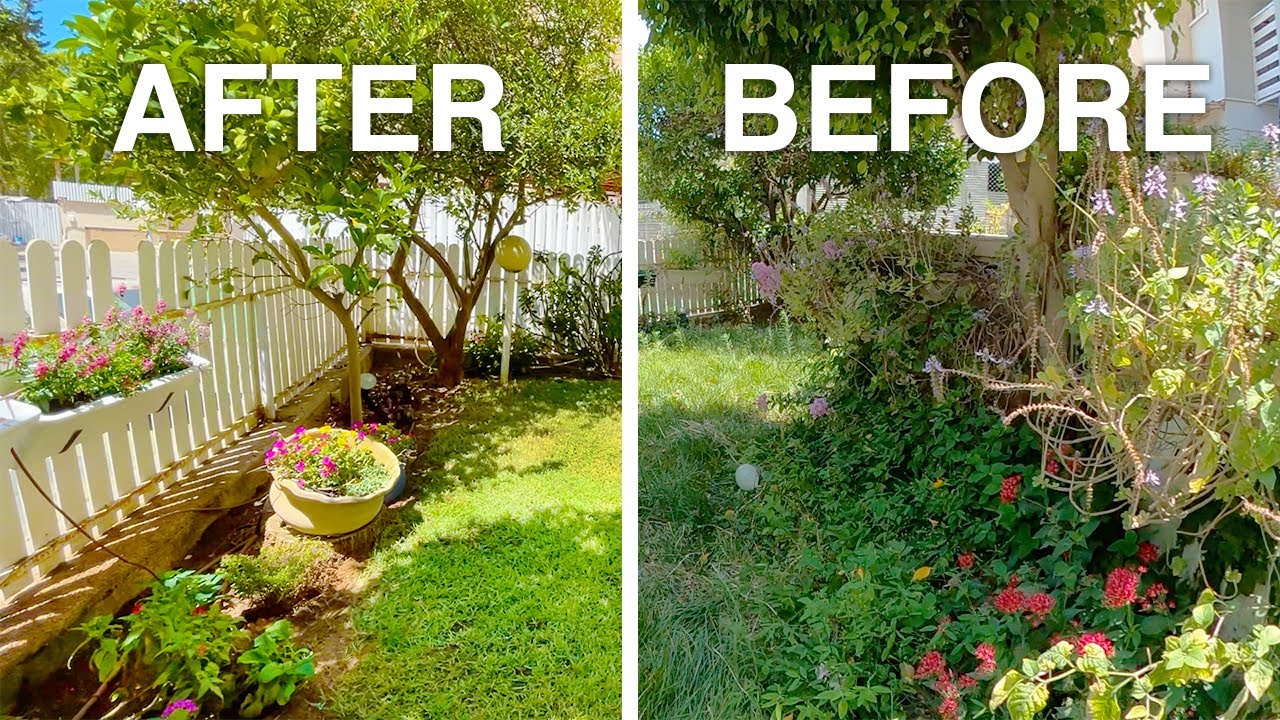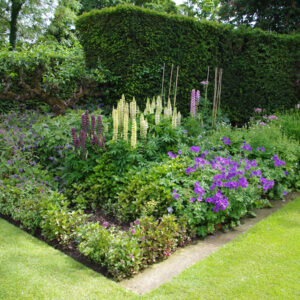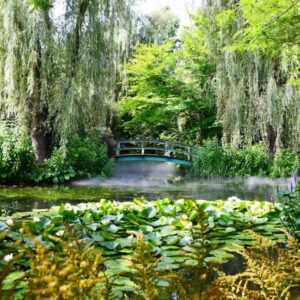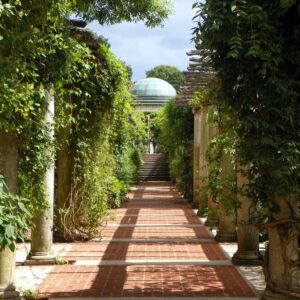Are you looking to transform your backyard into a paradise? With the right plan in place, it is possible to create an outdoor haven perfect for entertaining and relaxation.
From assessing your space to selecting plants and designing a layout, this step-by-step garden makeover guide specifically tailored for New Jersey will help you bring the vision of your dream garden to life.
Imagine yourself surrounded by lush green foliage, vibrant flowers, and illustrations of natural beauty evoking a sense of peace. Create a magical experience by installing lighting that illuminates the space as night falls.
Finally, maintain your garden with proper care so that it can remain an oasis for years to come.
Key Takeaways
- Assess the space, soil health, sun exposure, and maintenance requirements before starting a backyard garden makeover in New Jersey.
- Choose a garden style based on the climate, sunlight, and soil quality of the area. Popular options include formal, Japanese, wildflower meadows, and cottage gardens.
- Consider incorporating both native and exotic plant species for beauty, diversity, and sustainability. Native plants are well adapted to the local soil and climate, while exotic plants may require more maintenance but bring unique beauty.
- Proper care and maintenance are essential for a beautiful garden. Regular watering, pruning, and weeding are important tasks that vary depending on the plant type. Organic fertilizers can improve soil quality and provide nutrients for optimal plant growth.
Assess Your Space
An effective garden makeover begins with an assessment of the space available. This includes assessing the soil health, sun exposure, and other factors that will determine what kind of plants and design elements will work best in your backyard. It is important to take into consideration not only what you want your garden to look like but also how much maintenance it requires.
Additionally, consider any existing structures or trees that could affect light levels or present challenges when planning a design. For example, if you have a large tree in the middle of your yard, this may limit where certain plants can be placed.
Furthermore, it is important to think about drainage patterns as poorly draining soil can lead to standing water which can damage plants and create breeding grounds for pests and disease-carrying insects.
Once you have assessed your space, you are ready to choose a garden style that suits your needs and preferences.
Choose Your Garden Style
Investigating the truth of various garden styles can help create a paradise in one’s outdoor living space.
Garden styles convey an overall look and feel that is based on planting techniques, colors, and shapes.
The most popular garden styles include:
- Formal gardens – These are highly structured gardens with geometric shapes such as circles or squares, symmetrical layouts, and perfectly manicured plants.
- Japanese gardens – These gardens feature winding pathways, ponds or streams with bridges over them, stones for meditation spots, and carefully pruned shrubs and trees.
- Wildflower meadows – This is a naturalistic garden style featuring native wildflowers which require little maintenance while providing abundant nectar to pollinators like bees.
- Cottage gardens – These are informal designs typically featuring an array of flowers along with vegetation that provide shade requirements or improves soil quality such as herbs and vegetables in raised beds.
When selecting a style for your backyard it is important to consider the climate zone you live in as well as how much time you have available to maintain your garden design.
You should also take into account the amount of sunlight the area receives each day since some plants prefer more shade than others.
Additionally, understand your soil quality so you will know which types of plants will thrive in your yard before making any decisions about what type of garden style to choose for transforming your outdoor living space into a paradise.
From there, it’s time to select the right plants that fit within your chosen theme!
Select Your Plants
When selecting plants for a garden in New Jersey, it is important to consider the native and exotic species available.
Plant size and growth rate are also key elements that should be taken into account when planning a successful garden.
A variety of native flowers, shrubs, and trees can provide an attractive palette of colors while still being well-suited to the regional climate.
Exotic species may bring an added level of complexity or visual interest, but care must be taken to ensure they are appropriate for the local environment.

Native vs. Exotic Species
Comparing native and exotic species when transforming a backyard into a paradise is an important step in the garden makeover process. Native plants are well adapted to local soil and climate, while exotic plants can bring unique beauty and color to the garden. It is essential to consider both options when making decisions for your backyard:
- Native species provide better survival rates as they are already adapted to the local soil and environment.
- Exotic species often require more maintenance due to their need for special care or different pH levels of native soil.
- Exotic pests may be harder to control, so research is necessary before introducing them into the space.
- Native plants may lack variety compared to exotic species, but they usually have longer life spans and are pest-resistant due to their adaptation with local conditions.
Incorporating both native and exotic species can create a unique blend of beauty, diversity, and sustainability in your garden while also managing potential risks from pests or disease associated with introducing non-native varieties. Careful selection of plant size and growth rate will help ensure that your gardening efforts result in a stunning outdoor paradise that you’ll enjoy for years to come!
Plant Size and Growth Rate
Considering the varying growth rates and sizes of plants is essential when selecting which species to incorporate into a garden. Knowing whether a plant will stay relatively small or grow quickly and be large within a few years is important to plan for in order to achieve the desired aesthetic look.
The soil preparation should also take into account the rate of growth, as well as differences between native and exotic species. Additionally, mulching techniques may need to be adjusted if one or more species grow too quickly.
An effective garden design should take all these factors into consideration in order to create an aesthetically pleasing and environmentally friendly space. Furthermore, it is necessary to consider how each selection will interact with its surrounding plants and balance the overall composition of the garden.
With this knowledge, it becomes easier to choose which species are best suited for the particular landscape before moving on to designing your layout.
Design Your Layout
Designing a layout for your backyard garden is an essential step towards transforming it into a paradise. It involves carefully considering how you want to arrange the plants, as well as other elements such as pathways, furniture, and decorations. The first step is to assess the soil quality of your garden and make any necessary preparations for growing plants by adding nutrients, removing weeds, and controlling pests. After that, you need to decide on the size and shape of your garden. Consider whether you will be planting in beds or pots, what type of material will work best for walkways or seating areas.
| Element | Material |
|---|---|
| Pathway | Brick/Gravel |
| Seating Area | Wood/Stone |
| Plant Containers | Clay/Plastic Pots |
Once these decisions are made, you can begin sketching out your design using graph paper or a landscape planning app. Think about how each element should be placed relative to one another – where do you want the pathways to go? Where should seating areas be located? How much space should be allotted for each plant container? Make sure all elements are proportional so that it looks balanced when finished. To further enhance your design, consider installing lighting fixtures along pathways or around seating areas – this will create a beautiful ambiance in the evenings!
Install Lighting
Designing your backyard layout is an important first step in transforming it into a paradise, but the details are what will make it truly special. Installing lighting should be one of those details that you consider.
Outdoor lighting not only adds beauty to your garden, but also provides safety and security for your space. When choosing lights for your backyard, be sure to look for energy efficient options that will help reduce your energy consumption without sacrificing quality. Pathway and patio lights can add charm and ambience, while spotlights can make certain features stand out more. Consider LED or solar-powered lights as they are often the most energy efficient options available.
When installing outdoor lighting, keep safety in mind by avoiding exposed wiring or cords and use waterproof covers if needed. Also ensure that all wiring is adequately protected against water damage from rain or sprinklers by burying them deep underground or using waterproof seals around connections. Finally, do some research on any local laws regarding outdoor lighting before purchasing any fixtures so you don’t accidentally violate codes with the installation of your new garden lighting system.
With these considerations in mind, you’ll be able to install the perfect lighting system for your backyard paradise – one that brightens up the area while saving energy at the same time!
Maintaining a beautiful garden requires regular upkeep; next we’ll discuss how to properly care for your plants and lawn to keep them looking their best year round.
Maintain Your Garden
Gardening is a rewarding and enjoyable activity that requires effort to keep your garden looking its best.
Watering, pruning, and weeding are all important components of garden maintenance that need to be addressed in order to ensure your plants remain healthy and productive.
Each task requires specific knowledge and techniques depending on the type of plant you have in your garden; investing the time to learn these skills will help you maintain a thriving garden for years to come.
Watering
Watering is an essential part of garden upkeep, as it ensures plants receive the necessary hydration to remain healthy and vibrant. Gardeners in New Jersey have access to a variety of watering methods, from manual hand-watering with hoses or watering cans to automated irrigation systems. The table below outlines some advantages and disadvantages of each.
| Watering Method | Advantages | Disadvantages |
|---|---|---|
| Manual Hand-Watering | Cost Effective; Flexible Schedule | Time Consuming; Water Loss Through Evaporation |
| Automated Irrigation Systems | Easy Setup; No Human Error Involved | Expensive; Not Environmentally Friendly |
Manual hand-watering requires more labor but is cost effective and allows for flexibility with the schedule. Automated irrigation systems are convenient but require a higher initial investment and may not be environmentally friendly. After considering these factors, gardeners can decide which method best fits their needs. With proper maintenance, this will allow them to keep their gardens looking beautiful for years to come. Pruning and weeding are also important practices for maintaining a healthy garden environment.
Pruning and Weeding
Once the watering of plants in a garden is complete, the next step to transforming a backyard into a paradise is pruning and weeding.
Pruning is important for improving air circulation, preventing disease and damage caused by insects, as well as giving plants their desired shape. It also helps to remove dead or diseased parts of the plants.
Weeding involves removing unwanted weeds from the garden which can compete with other plants for nutrients, water, sunlight and space.
Organic fertilizers can be used to improve soil quality and provide additional nutrients for better growth of plants in a garden. Fertilizers should be applied at least twice every year – once in early spring and then again in late summer – to ensure that all nutrients needed are available throughout the growing season.

Frequently Asked Questions
What is the best time of year to start a garden makeover?
Beginning with a flourish, the best time to plan ahead and start a garden makeover is in the spring when climate control is optimal. This allows for plants to thrive and growth to be maximized while ensuring flora receive adequate sunlight.
What are the average costs associated with a garden makeover?
Budgeting for a garden makeover requires consideration of soil amendments, plants, and tools. Average costs depend on the size and scope of the project, as well as quality of materials used. Tips include researching options for cost-effective soil products and purchasing perennials over annuals.
How much time is required to complete a garden makeover?
The amount of time required to complete a garden makeover depends on factors such as plant selection and soil preparation. Generally, it takes several days or weeks to finish the project, depending on the complexity of the design.
Are there any specific regulations or requirements in New Jersey for garden design?
In New Jersey, landscaping permits may be required depending on the scope of the project, and native plants are highly encouraged to ensure a thriving garden environment.
Are there any special tools or equipment needed to complete a garden makeover?
Anachronistically speaking, garden makeovers require the use of special tools and equipment like watering systems and pest control. Knowing which ones to use is essential for a successful result; be sure to select options that are suitable for your particular climate.
Conclusion
As this garden makeover guide in New Jersey has demonstrated, transforming an ordinary backyard into a paradise is within reach. With careful planning and attention to detail, the right combination of styles, plants, and lighting can create a stunning outdoor space.
Through thoughtful selection of colors and textures, one can achieve a perfect balance between natural beauty and man-made elegance. From choosing the ideal style for your garden to maintaining it with regular care, this step-by-step guide will help you turn your dreams into reality.
Let your imagination run wild as you shape your backyard into an oasis of relaxation and enjoyment!





